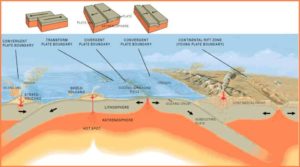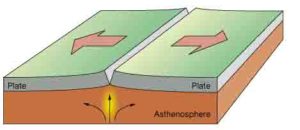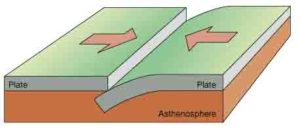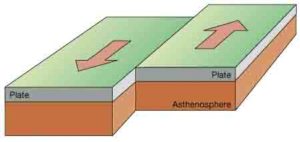
What are Plate Boundaries?
Plate boundaries are the edges where two plates meet. Most geologic activities, including volcanoes, earthquakes, and mountain building, take place at plate boundaries. “Read More about: What is Plate Tectonics? “
What are the 4 types of plate boundary?
There are four types of plate boundaries: Divergent boundaries — where new crust is generated as the plates pull away from each other. Convergent boundaries — where crust is destroyed as one plate dives under another.
- Divergent boundaries: where new crust is generated as the plates pull away from each other.
- Convergent boundaries: where crust is destroyed as one plate dives under another.
- Transform boundaries: where crust is neither produced nor destroyed as the plates slide horizontally past each other.
- Plate boundary zones: broad belts in which boundaries are not well defined and the effects of plate interaction are unclear.
Plate Boundary Types
Divergent boundary (Constructive)
Occurs when two tectonic plates move away from each other. Along these boundaries, lava spews from long fissures and geysers spurt superheated water. Frequent earthquakes strike along the rift. Beneath the rift, magma—molten rock—rises from the mantle.

It oozes up into the gap and hardens into solid rock, forming new crust on the torn edges of the plates. Magma from the mantle solidifies into basalt, a dark, dense rock that underlies the ocean floor. Thus at divergent boundaries, oceanic crust, made of basalt, is created.
Convergent boundary (Destructive)

When two plates come together, The impact of the two colliding plates buckles the edge of one or both plates up into a rugged mountain range, and sometimes bends the other down into a deep seafloor trench. A chain of volcanoes often forms parallel to the boundary, to the mountain range, and to the trench. Powerful earthquakes shake a wide area on both sides of the boundary.
If one of the colliding plates is topped with oceanic crust, it is forced down into the mantle where it begins to melt. Magma rises into and through the other plate, solidifying into new crust. Magma formed from melting plates solidifies into granite, a light colored, low-density rock that makes up the continents. Thus at convergent boundaries, continental crust, made of granite, is created, and oceanic crust is destroyed.
Transform boundaries (Conservative)

Two plates sliding past each other, Natural or human-made structures that cross a transform boundary are offset—split into pieces and carried in opposite directions. Rocks that line the boundary are pulverized as the plates grind along, creating a linear fault valley or undersea canyon. As the plates alternately jam and jump against each other, earthquakes rattle through a wide boundary zone. In contrast to convergent and divergent boundaries, no magma is formed. Thus, crust is cracked and broken at transform margins, but is not created or destroyed.
Plate boundary zones
Plate boundary zones occur where the effects of the interactions are unclear, and the boundaries, usually occurring along a broad belt, are not well defined and may show various types of movements in different episodes.










